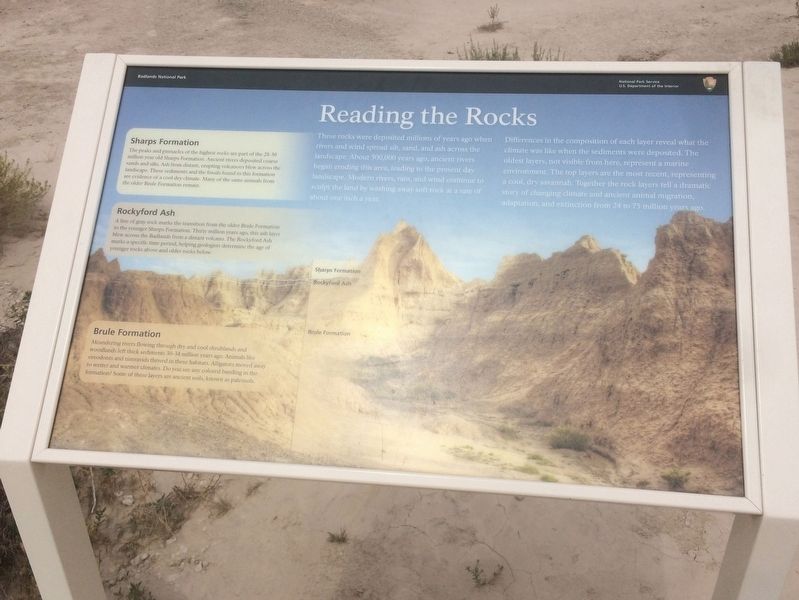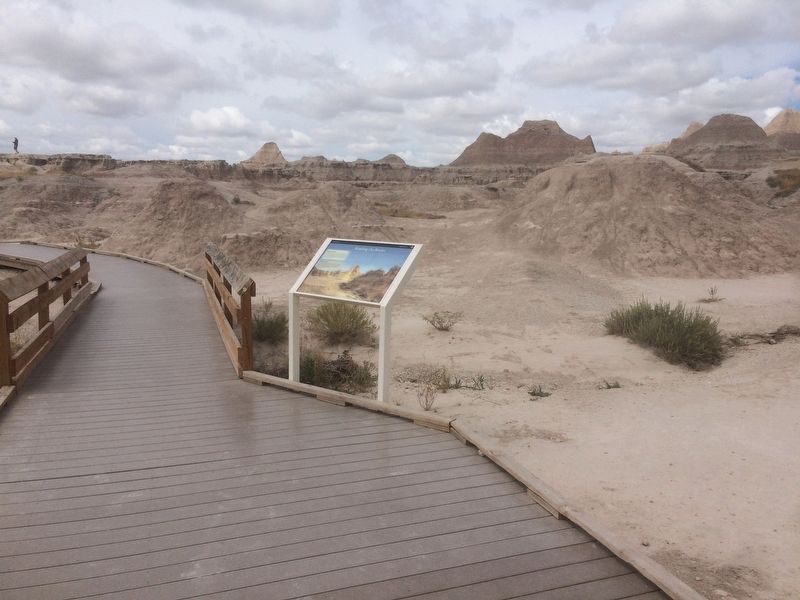Near Interior in Jackson County, South Dakota — The American Midwest (Upper Plains)
Reading the Rocks
These rocks were deposited millions of years ago when rivers and wind spread silt, sand, and ash across the landscape. About 500,000 years ago, ancient rivers began eroding this area, leading to the present day landscape. Modern rivers, rain, and wind continue to sculpt the land by washing away soft rock at a rate of about one inch a year.
Differences in the composition of each layer reveal what the climate was like when the sediments were deposited. The oldest layers, not visible from here, represent a marine environment. The top layers are the most recent, representing a cool, dry savannah. Together the rock layers tell a dramatic story of changing climate and ancient animal migration, adaptation, and extinction from 24 to 75 million years ago.
Sharps Formation
The peaks and pinnacles of the highest rocks are part of the 28 - 30 million year old Sharps Formation. Ancient rivers deposited coarse sands and silts. Ash from distant, erupting volcanoes blew across the landscape. These sediments and fossils found in this formation are evidence of a cool dry climate. Many of the same animals from the older Brule Formation remain.
Rockyford Ash
A line of gray rock marks the transition from the older Brule Formation to the younger Sharps Formation. Thirty million years ago, this ash layer blew across the Badlands from a distant volcano. The Rockyford Ash marks a specific time period, helping geologists determine the age of younger rocks above and older rocks below.'
Brule Formation
Meandering rivers flowing through dry and cool shrublands and woodlands left thick sediments 30-34 million years ago. Animals like oreodonts and nimravids thrived in these habitats. Alligators moved away to wetter and warmer climates. Do you see any colored banding in the formation? Some of these layers are ancient soils, known as paleosols.
Erected by Badlands National Park, National Park Service, U.S. Department of the Interior.
Topics. This historical marker is listed in these topic lists: Environment • Parks & Recreational Areas.
Location. 43° 46.326′ N, 102° 0.263′ W. Marker is near Interior, South Dakota, in Jackson County. Marker is on State Highway 240. This marker is part of the Fossil Trail Exhibit. The Fossil Trail Exhibit is located 5 miles west of the Ben Reifel Visitor Center. Touch for map. Marker is in this post office area: Interior SD 57750, United States of America. Touch for directions.
Other nearby markers. At least 8 other markers are within walking distance of this marker. It's a Dog's Life (here, next to this marker); Fight for Survival (within shouting distance of this marker); Dying to Become a Fossil (within shouting distance of this marker); Off to the Races (within shouting distance of this marker); See Ya Later, Alligator (within shouting distance of this marker); Titanic Discovery (within shouting distance of this marker); Under the Sea (within shouting distance of this marker); What a Find! (about 300 feet away, measured in a direct line). Touch for a list and map of all markers in Interior.
Related markers. Click here for a list of markers that are related to this marker.
Also see . . . Badlands National Park. (Submitted on January 21, 2018, by Ruth VanSteenwyk of Aberdeen, South Dakota.)
Credits. This page was last revised on January 23, 2018. It was originally submitted on January 21, 2018, by Ruth VanSteenwyk of Aberdeen, South Dakota. This page has been viewed 228 times since then and 6 times this year. Photos: 1, 2. submitted on January 21, 2018, by Ruth VanSteenwyk of Aberdeen, South Dakota. • Andrew Ruppenstein was the editor who published this page.

